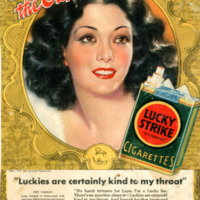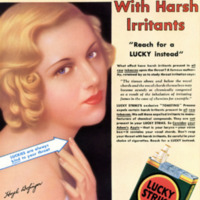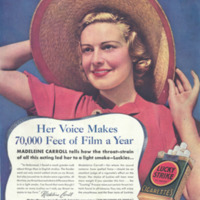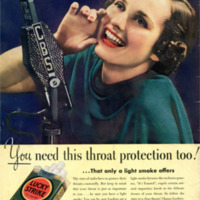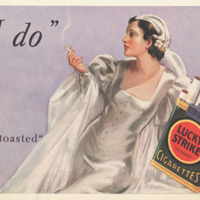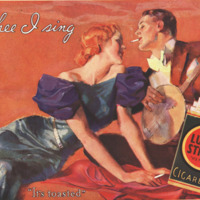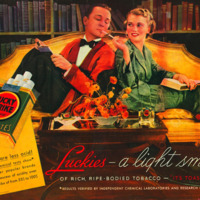Love and Femininity Advertisements
The promotion of the new market sought to eliminate the cultural and social stigmas of female nicotine consumption, which were generally associated with masculine imagery. Advertisements promoting love and femininity focused on portraying women as pure and loving, as well as socially desirable. The purpose was to make consumption of cigarettes appear safer and healthier to female customers. Prior to the introduction of the female smoker in advertisements, women often smoked in private, which posed challenges for companies seeking to transform the social norms of American society. Advertisers sought to appeal to women by denouncing the masculine stereotypes of smoking, and by promoting concepts of freedom, self-importance, and rebellion.[1] Smoking was considered vulgar and showed lack of morals in women, it was also believed to reduce her changes to marry. Moreover, smoking was considered grounds for dismissal in some American school districts for female teachers, alongside regional laws intended to limit women smoking in public.[2] Many of the images aimed to appeal to young and impressionable women and girls seeking to emulate or acquire attributes of the women in the cigarette advertisements.[3] The promotion of the new market sought to eliminate the cultural and social stigmas of female nicotine consumption, which were generally associated with masculine imagery: “Therefore, it is important to look back, particularly to the twenties, thirties, and forties, when addiction became synonymous with freedom for women.”[4] Smoking also became synonymous with femininity and love, which were both highly valued by the female consumer.
In order to promote the notions of love and femininity, advertisers used various campaigns and slogans. According to Doxey and Hammond: “Tobacco marketing played a critical role in the rise of female smoking in North America. The launch of new female brands and advertising campaigns targeting themes of female independence and sophistication helped to shift social norms, and positioned smoking as a modern, progressive behaviour for young women.”[5] Indeed, the packaging itself helps promote tobacco consumption among women, and remained one of the most important marketing tools. In addition to the packaging, the image that was promoted in the advertisements was critical to the overall success of the campaigns. The campaigns included: “Consider Your Adam’s Apple,” “Couples in Love,” and “Sunshine Mellows,” all of which spouted feminine and sensual imagery. Advertisements had various purposes, some to promote the ideal woman, some used celebrity endorsement to sell the products, and others encouraged openness and public smoking.
A Closer Look:
In the advertisements on “Consider Your Adam’s Apple,” the women are pictured holding their throats. The purpose was to promote the healthful angle of smoking, showing that the lightness of Lucky Strike cigarettes was better for their throat than any other brand. These sorts of advertisements, as well as one’s that promoted “Cream of the Crop” or throat protection, commonly used celebrity endorsement to encourage women to buy into the image of the female smoker. Celebrities often got involved in advertising due to the connection between the tobacco industry and Hollywood, which allowed Lucky Strike to use endorsement in return for extra publicity for the stars upcoming film. These advertisements featured young beautiful starlets, claiming Lucky Strike as their choice of tobacco product. “Achieving a glamorous, celebrity lifestyle became seemingly more attainable with the rise of the marketing culture that offered easier access to mass produced goods designed to make everyday life easier. Celebrity endorsements made mudane artifacts objects of desire that consumer readily paid for in an attempt to emulate Hollywood and sports stars.”[6] The conscious consumerism often resulted from the desire for a more fulfilling lifestyle. Interesting, the consequences of this is that once one object is attained, desire for another emerges, which creates a never-ending cycle of desire that is often unattainable. Thus, the American Tobacco Company would continue to use different slogans to advertise the product to women to consistently keep them interested and encourage mass consumption.[7] the ‘cult of personality’ was brought out in the advertisements, making the celebrities appear to be friends with the female observer, which all connects back to identity of the consumer.[8] Since paid endorsements had to be declared in the advertisements, Lucky Strike used tactics to phrase it in a way to make the message effective while not straying from the truth entirely. Endorsement contracts were also used to specify the name, photograph, and publicities that were to be included, which had to be signed by the advocate.[9] Celebrities ultimately brought out notions of femininity through their appearance and endorsement of the Lucky Strike product.
In addition, imagery plays an important role in tobacco advertising, as the power is in the image: “seeing is believing in the sense that it’s part of your experience. You often don’t even register the thought…so the advertising by use of associative imagery is very potent.”[10]Some advertisements used brides to connect the product with a sense of traditions, customs, and perhaps a rite of passage. As seen in the advertisement “I Do” the woman is dressed in a white wedding gown, smoking a cigarette, which was symbolic of femininity, purity, and sanitization. The purpose was to promote the tobacco as pure and clean, and in turn safer and healthier. The term “I Do” could mean yes to a marriage, or yes as if to answer the question concerning whether or not she smokes. Furthermore, the “Couples in Love” campaign sought to portray smoking as romantic. In “Of Thee I Sing, the image focuses on romance and sensuality, but the red, white, and blue colouring also symbolizes freedom and liberation, which are both important American values. The advertisement with the man and woman sitting on a couch is significant for its use of colour as well, since the clothes and the couch itself represent the colours on the cigarette package. Indeed, the love and romance angle was used to encourage women to further engage in smoking and to make it appear desirable.
The introduction of the female smoker meant that the American Tobacco Company would be able to expand its market share, yet unless it was also accepted by society, the profitability would only increase by so much: “If cigarette smoking was to be a respectable activity for women, it would have to be a public one.”[11] Indeed, during the Depression years, most magazines and newspapers had advertisements for tobacco products for both men and women. Despite opposition, women began smoking in places such as diners, retail stores, art galleries, and so forth in the late 1920s, and especially the 1930s. To promote the idea that smoking in public was acceptable, the advertisements sought to place women in a public setting, such as the beach. The ads also promoted the health angle, as it explains the benefit of sunshine. It incorporates the toasting process in its slogans, claiming the tobacco leafs as sanitary and pure. However, while the cigarettes signified urbanity, sophistication, and modernity, from a gender standpoint there was still bias against women smoking in the advertising. Indeed, in the “Sunshine Mellows” campaign, there is a reluctance to show the woman smoking the cigarette; instead it subtly suggests women can smoke without actually showing it.[12] In fact, in a national survey done in 1937, it found that 95% of respondents thought men could smoke openly in the street, while only 28% though women should have the same privilege.[13] Advertisements eventually became more open to authorizing public smoking for both men and women unanimously. As a result, the acceptance of the female smoker became more widespread in American society after the 1930s.
[1] Cheryl Krasnick Warsh, “Smoke and Mirrors: Gender Representation in North American Tobacco and Alcohol Advertisements Before 1950,” Social History Vol. 31 No. 62(1998): 189, https://hssh.journals.yorku.ca/index.php/hssh/article/view/4665
[2] Phyllis Marie Jensen, “A History of Women and Smoking.” Canadian Women Studies Vol. 14 No. 3 (1994): 29, https://cws.journals.yorku.ca/index.php/cws/article/view/9758
[3] Virginia Ernster, Nancy Kaufman, Mimi Nichter, Jonathan Samet, and Soon Yoon, “Women and Tobacco: Moving from Policy to Action,” World Health Organization Vol. 78 No. 7 (2000): 894, https://go.galegroup.com/ps/retrieve.do?tabID=T002&resultListType=RESULT_LIST&searchResultsType=SingleTab&searchType=AdvancedSearchForm¤tPosition=1&docId=GALE%7CA65229065&docType=Article&sort=RELEVANCE&contentSegment=&prodId=AONE&contentSet=GALE%7CA65229065&searchId=R1&userGroupName=otta77973&inPS=true
[4] Warsh, “Smoke and Mirrors,” 184.
[5] Juliana Doxey and David Hammond, “Deadly in Pink: The Impact of Cigarette Packaging Among Young Women,” Tobacco Control Vol. 20 No. 5 (2011): 353, https://www.jstor.org.proxy.bib.uottawa.ca/stable/41320165?seq=1#page_scan_tab_contents
[6] Maja Bajac-Carter and Norma Jones, “Reach for a Lucky Instead of a Sweet: An Exploration of Early Cigarette Advertising,” in We Are What We Sell: How Advertising Shapes American Life…And Always Has Volume 1, e. Danielle Sarver Coombs and Bob Batchelor (Santa Barbara, California: Prager, ABC-CLIO, LLC, 2014), 126.
[7] Bajac-Carter, “Reach for a Lucky,” 128.
[8] Sharon A. Cook, Sex, Lies, and Cigarettes Canadian Women, Smoking, and Visual Culture, 1880-2000 (Montreal: McGill-Queen’s University Press, 2012) 210.
[9] Lum, K. L., J. R. Polansky, R. K. Jackler, and S. A. Glantz. “Signed, Sealed and Delivered: “Big Tobacco” in Hollywood, 1927-1951.” Tobacco Control Vol. 17 No. 5 (2008): 318, https://tobaccocontrol.bmj.com/content/tobaccocontrol/17/5/313.full.pdf
[10] Richard Pollay, “Tricks of the Tobacco Trade,” Journal of Business Administration and Policy Analysis Vol. 24-26 (1996-98): 228, https://go.galegroup.com.proxy.bib.uottawa.ca/ps/retrieve.do?tabID=T003&resultListType=RESULT_LIST&searchResultsType=SingleTab&searchType=AdvancedSearchForm¤tPosition=1&docId=GALE%7CA54429829&docType=Transcript&sort=RELEVANCE&contentSegment=&prodId=AONE&contentSet=GALE%7CA54429829&searchId=R1&userGroupName=otta77973&inPS=true
[11] Warsh, 197.
[12] William H. Younh and Nancy K. Young. The Great Depression in America: A Cultural Encyclopedia, Volume 2. (Westport: Greenwood Press, 2007), 7.
[13] Young and Young, The Great Depression, 7.
